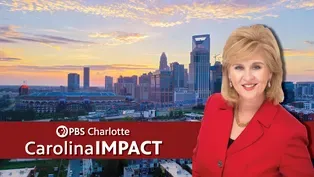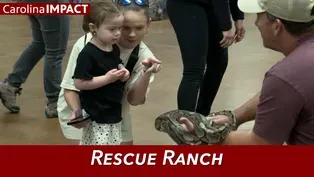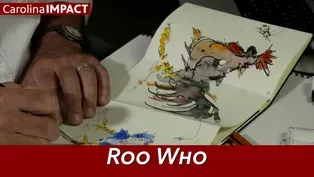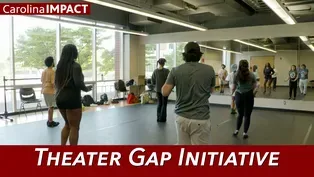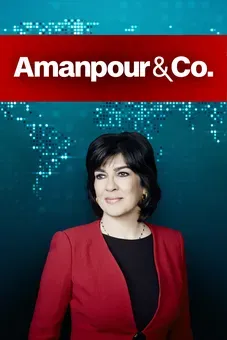
Construction Sustainability
Clip: Season 12 Episode 1206 | 5m 52sVideo has Closed Captions
The Carbon Cure process - making concrete production safer for the environment.
Thomas Concrete is using a new technology called Carbon Cure, which merges science and technology to make the process of making concrete safer for the environment. The process involves trapping emissions and re-injecting them back into the concrete mix. Carolina Impact takes a look at Construction Sustainability.
Problems with Closed Captions? Closed Captioning Feedback
Problems with Closed Captions? Closed Captioning Feedback
Carolina Impact is a local public television program presented by PBS Charlotte

Construction Sustainability
Clip: Season 12 Episode 1206 | 5m 52sVideo has Closed Captions
Thomas Concrete is using a new technology called Carbon Cure, which merges science and technology to make the process of making concrete safer for the environment. The process involves trapping emissions and re-injecting them back into the concrete mix. Carolina Impact takes a look at Construction Sustainability.
Problems with Closed Captions? Closed Captioning Feedback
How to Watch Carolina Impact
Carolina Impact is available to stream on pbs.org and the free PBS App, available on iPhone, Apple TV, Android TV, Android smartphones, Amazon Fire TV, Amazon Fire Tablet, Roku, Samsung Smart TV, and Vizio.

Introducing PBS Charlotte Passport
Now you can stream more of your favorite PBS shows including Masterpiece, NOVA, Nature, Great British Baking Show and many more — online and in the PBS Video app.Providing Support for PBS.org
Learn Moreabout PBS online sponsorship(horns honking) It's a scene playing out all across Charlotte, building construction.
When it opens next summer, the Queensbridge mixed use development in South End will include a 42-story residential tower, a 35-story office tower, and nearly 30,000 square feet of retail space.
For now, workers carry up supplies, grab a quick bite to eat and get right back to work.
And everywhere you look, you see one of the main ingredients of building construction: concrete.
But before we go any further, let's clarify something.
What exactly is concrete and what is cement and what's the difference?
- If you bake a cake and you use flour to make the cake, cement is flour.
Concrete is the cake.
- Concrete is made by mixing Portland cement with rock, water, sand, and some chemical admixtures.
(jazzy music) - [Jason] Thomas Concrete is a local company whose roots traced back to Sweden, a family owned business that began in 1955 and expanded to the US in 1985.
- So it's roughly 50 to 60% of the group's business is here in the United States.
- We have eight plants in the Charlotte area.
The company isn't the largest concrete producer in the area in terms of size or sales.
- We're not the market leader here.
We're a smaller company here.
Like I said, we're not gonna be the biggest here, wanna be the best to work for, best to buy from.
- [Jason] But they are leading the way in something else: Sustainability.
- One of our company goals is to be environmentally responsible.
- Thomas Concrete Group has been working with sustainability issues since long before it became a word on people's lips and it's really because we care.
- A long-term sustainable vision has always been part of the Thomas Concrete mission.
- We focus on the things that makes the biggest difference, both for people and the planet.
- [Jason] Cement makes up only about 10% of finished concrete, yet it contributes to about 90% of its overall carbon dioxide output.
And cement production contributes 8% of global carbon emissions.
- Concrete by sheer volume is going to have an impact on the environment and we feel there's responsibility there to understand our product in a way, not just the product, but to understand the impact that it has and to do what we can to mitigate it.
There's a lot we can do.
- My name is Jeff Sanders.
I'm the GM for Thomas here in Charlotte.
Wanna welcome everyone to our event.
We're pretty proud of the CarbonCure journey that we're on and excited to share it with those of you who are here.
- [Jason] At a recent event for customers and associates at Olde Mecklenburg Brewery, representatives from Thomas Concrete shared the story of the CarbonCure process and what it could potentially mean long-term for the environment.
- We're proud of the progress that we've made with CarbonCure to try to be more environmentally friendly.
- So we have been actively working since a long time to reduce the footprint by substituting cement with materials that has the similar properties but with a significant lower CO2 footprint than the cement.
- [Jason] So how exactly does the CarbonCure process work?
It's all very scientific and perhaps a little confusing to someone not in the industry, but what they're doing is experimenting with various binders.
That's the stuff used in the concrete mix that holds everything together.
Basically the glue.
- It is what creates that strength.
- The most important and the main alternative binders are slag byproduct from the steel industry and fly ash from coal fire power plants.
Those are the two main alternative binders that we operate with at the moment.
So we are also researching new alternative binders like volcanic ash, calcine clays, reclaimed fly ash, other types of slags from other types of similar industries like the steel industry.
- [Jason] Then they take what would normally be the CO2 emissions and instead of releasing it into the atmosphere, they trap it back into the concrete.
And by doing this, they can reduce CO2 emissions by as much as 50%.
- Alright, CarbonCure is a process where different producers or manufacturing facilities, they have processes that produce carbon instead of releasing it to the atmosphere, they'll release it into a container, they'll deliver it to our plants and we'll inject the carbon dioxide into the drum of the truck or the drum of the plant to reduce the amount of cement that we need.
- It is a process by which waste CO2 is taken that would've otherwise went into the atmosphere, but we take it and inject a precise dose of it into our concrete.
And that CO2 naturally wants to bind with the calcium oxide and the calcium rich material that we have in the truck.
And what happens is it becomes calcium carbonate, it mineralizes, and that increases the compressive strength and it permits less cement.
- [Jason] The CarbonCure process was featured on CNN a few years ago when the technology was first adopted.
- [CNN Reporter] But what if there was a way that instead of releasing carbon dioxide, concrete could trap it forever?
- [Jason] In Charlotte, the CarbonCure process is being implemented into construction of the Queensbridge project in South End, as well as the new 25-story residential tower going up in Valentine.
- Thomas in the US has produced, I think in the neighborhood of 6 million yards with the CarbonCure.
So it's been a pretty substantial number.
- [Jason] It's a challenge facing the entire industry, meeting the demands of anticipated infrastructure growth while decarbonizing construction.
Thomas is taking that challenge head on.
- We know that there's gonna be a lot of concrete coming over the next 50, 60 years and we wanna make sure that we, the concrete that we pour has the least amount of environmental impact possible.
Carolina Impact | October 29th, 2024 Preview
Construction Sustainability, Rescue Ranch, Roo Who, & Theater Gap Initiative. (30s)
Video has Closed Captions
A Statesville non-profit uses exotic animals to teach kids life skills. (5m 16s)
Video has Closed Captions
A Matthews artist documents and shares his adventures through journal and watercolor. (4m 28s)
Video has Closed Captions
A local group helps high school graduates pursue careers in the arts. (5m 39s)
Providing Support for PBS.org
Learn Moreabout PBS online sponsorshipCarolina Impact is a local public television program presented by PBS Charlotte
